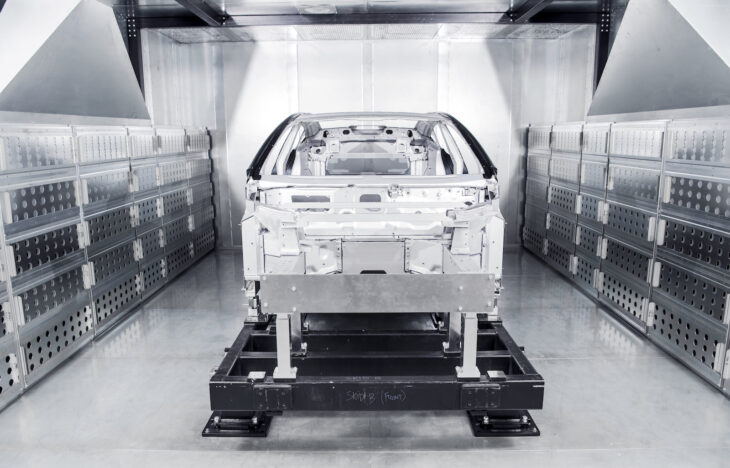Polestar, the Swedish premium electric performance car maker, announced that its forthcoming Polestar 5 four-door GT will feature a brand new, bespoke, bonded aluminum chassis. The bonded aluminum chassis was developed in-house by over 280 engineers from Polestar’s U.K. R&D team based in Coventry, England, and demonstrates Polestar’s industry leading in-house engineering and R&D capabilities
Bonded aluminum is lightweight and rigid, offering superlative performance and environmental advantages. While this technology has previously proven labor intensive and difficult to use in mass production vehicles without sacrificing quality, Polestar’s team of former Formula 1, low volume, and bespoke sports car engineers have resolved this challenge. The team created an entirely new, faster manufacturing process that develops both body and chassis in unison, significantly reducing traditional lead times.
As a result of the new materials and techniques involved, the body-in-white is expected to weigh less than smaller segment vehicles, contributing to improved vehicle efficiency, real-world EV range and dynamic responsiveness, while at the same time delivering leading safety levels. Moreover, the bonded aluminum platform will help drive faster product introduction, high quality and platform rigidity.
“Our U.K. R&D team is one of Polestar’s greatest assets,” said Thomas Ingenlath, Polestar CEO. “Their mix of engineering and technological expertise enables us to develop advanced, lightweight sports car technology with a creative mindset and a spirit that embraces innovative engineering. This will set Polestar apart in the years to come.”
By further developing this technology for Polestar’s first in-house platform, the four-door Polestar 5 is being designed with torsional rigidity superior to that of a traditional two-seat sports- or supercar. The decision to develop a bespoke platform has also enabled the brand to deliver a production model that remains true to the concept car that inspired it.
“We knew we wanted this car to be lightweight, we knew we wanted high quality, and we knew we wanted it quickly,” said Pete Allen, head of Polestar U.K. R&D. “This architecture delivers outstanding dynamic and safety attributes, with low investment technology applicable to high production volumes.”
Development of the Polestar 5 continues at pace, with global efforts led by a growing U.K. R&D unit, which is expected to grow to approximately 500 engineers in the coming months and will continue to play a critical role in enhancing Polestar’s in-house R&D capabilities. More details on Polestar 5 will continue to surface as the YouTube documentary series “Precept: From Concept to Car” details how the Polestar Precept evolves into the production car.
Polestar’s Use of Aluminum
Polestar has produced two electric performance cars. The Polestar 1 was built between 2019 and 2021 as a low-volume electric performance hybrid GT with a carbon fiber body, 609 hp, 1,000 Nm, and an electric-only range of 124 km (WLTP) — the longest of any hybrid car in the world (according to the company).
The Polestar 2 electric performance fastback was the company’s first fully electric, high volume car, which uses aluminum in multiple structures. By incorporating the battery within the aluminum structure of the Polestar 2, the company increased the safety of the vehicle. Enclosed in an aluminum case for protection and rigidity, the battery pack is fully housed within the floor structure of the Compact Modular Architecture (CMA) platform. This approach not only reduces the risk of damage and stiffens the body, it also protects occupants by keeping the battery intact in the event of a collision.
The Polestar 2 model range includes three variants with a combination of long- and standard range batteries as large as 78 kWh, and dual- and single-motor powertrains with as much as 300 kW / 408 hp and 660 Nm. The EV features a severe partial offset crash (SPOC) block, a solid aluminum block housed on the bottom edge of the front firewall on either side of the car, and the SPOC block is designed to minimize intrusion of the wheel and other vehicle components into the passenger cabin or from heading toward the battery pack during partially offset frontal collisions.
In addition, the battery is protected by three shields. The first is a rounded, hollow aluminum bar designed to deflect or absorb the impact of anything and turn it upwards away from the battery pack. The second is a titanium plate, and the third shield is a shallow angle, solid aluminum extrusion to absorb the residual impact energy.
Future Plans
The company has big plans to launch one new electric vehicle per year, starting with Polestar 3 in 2022 — the company’s first electric performance SUV. Polestar 4 is expected to follow in 2023, which will be a smaller electric performance SUV coupe.
In 2024, the Polestar 5 electric performance 4-door GT with the aluminum chassis is planned to be launched as the production evolution of Polestar Precept — the manifesto concept car (released in 2020) that showcases the brand’s future vision in terms of design, technology, and sustainability.
As the company seeks to reduce its climate impact with every new model, Polestar aims to produce a truly climate-neutral car by 2030.
About Polestar
Polestar was established as a new, standalone Swedish premium EV manufacturer in 2017. Founded by Volvo Cars and Geely Holding, Polestar enjoys specific technological and engineering synergies with Volvo Cars and benefits from significant economies of scale as a result.
Polestar is headquartered in Gothenburg, Sweden, and its vehicles are currently available in markets across Europe, North America, China, and Asia. By 2023, the company plans to be present in at least 30 global markets. Polestar cars are currently manufactured in two facilities in China, with additional future manufacturing planned in the U.S.

